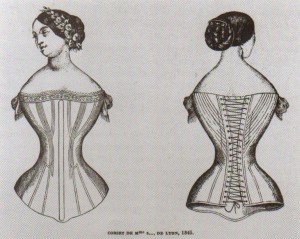Spiraling
December 22nd, 2010
Tonight I set the grommets* on the left half of my new stays. I would have done both halves, but somehow I feel funny about pounding grommets with a hammer on my apartment floor after 10 pm. My neighbors feel funny about it too.
I suppose I could have quietly worked the holes round in buttonhole stitch, an option suggested in the Workwoman’s Guide, published in 1838. But the Workwoman’s Guide also mentions “patent lace-holes,” noting that some people prefer them despite how hard they are on your laces. By 1857, Godey’s doesn’t even mention working the holes, but presumes you are going to use “a box of French holes; and a punch for putting them in.”
I made another exciting discovery about the stay pattern though. They are meant to be spiral laced! For those of you who aren’t corset aficionados, this means that the holes on each side of the stays don’t line up. When you place the two rows of lacing holes next to each other, they alternate. There are two holes very close together at the top of one side, and a similar pair of holes at the bottom of the other side. The lace is tied to the top double holes, then run around and around like a spiral through the rest of the evenly spaced holes. It’s tied off in the bottom double holes.
Generally, costumers associate spiral lacing with medieval or renaissance corsetry. But the above picture (cribbed from Valerie Steele’s The Corset) proves that spiral lacing was going on in 1845. And the Godey’s pattern I’m using proves it was still happening in 1857 too!
Spiral lacing isn’t particularly useful for waist cinching, but in the 1840s and 50s, stays weren’t meant to be such rigorous under-armor as later corsets were. I’ve read a few opinions online suggesting that cross lacing came in at the same time as the front opening busk. I’ve yet to hunt for sources to confirm this hypothesis, but I am inclined to agree.
*As per my dear friend Zoh’s advice, I do plan to get the grommets professionally set when I make my “real” stays. This pair is just to practice construction, perfect the fit, and see how well they wear.

